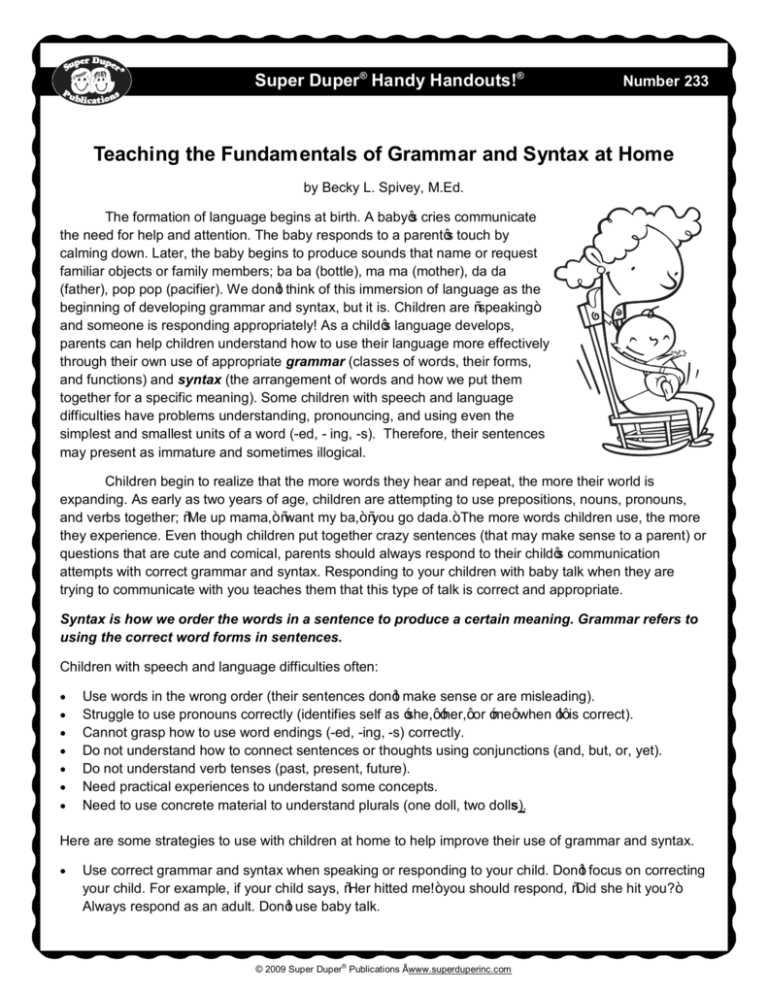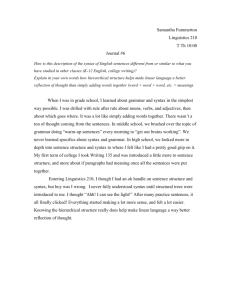Teaching the Fundamentals of Grammar and Syntax at Home
advertisement

Super Duper® Handy Handouts!® Number 233 Teaching the Fundamentals of Grammar and Syntax at Home by Becky L. Spivey, M.Ed. The formation of language begins at birth. A baby’s cries communicate the need for help and attention. The baby responds to a parent’s touch by calming down. Later, the baby begins to produce sounds that name or request familiar objects or family members; ba ba (bottle), ma ma (mother), da da (father), pop pop (pacifier). We don’t think of this immersion of language as the beginning of developing grammar and syntax, but it is. Children are “speaking” and someone is responding appropriately! As a child’s language develops, parents can help children understand how to use their language more effectively through their own use of appropriate grammar (classes of words, their forms, and functions) and syntax (the arrangement of words and how we put them together for a specific meaning). Some children with speech and language difficulties have problems understanding, pronouncing, and using even the simplest and smallest units of a word (-ed, - ing, -s). Therefore, their sentences may present as immature and sometimes illogical. Children begin to realize that the more words they hear and repeat, the more their world is expanding. As early as two years of age, children are attempting to use prepositions, nouns, pronouns, and verbs together; “Me up mama,” “want my ba,” “you go dada.” The more words children use, the more they experience. Even though children put together crazy sentences (that may make sense to a parent) or questions that are cute and comical, parents should always respond to their child’s communication attempts with correct grammar and syntax. Responding to your children with baby talk when they are trying to communicate with you teaches them that this type of talk is correct and appropriate. Syntax is how we order the words in a sentence to produce a certain meaning. Grammar refers to using the correct word forms in sentences. Children with speech and language difficulties often: · · · · · · · Use words in the wrong order (their sentences don’t make sense or are misleading). Struggle to use pronouns correctly (identifies self as ‘she,’ ‘her,’ or ‘me’ when ‘I’ is correct). Cannot grasp how to use word endings (-ed, -ing, -s) correctly. Do not understand how to connect sentences or thoughts using conjunctions (and, but, or, yet). Do not understand verb tenses (past, present, future). Need practical experiences to understand some concepts. Need to use concrete material to understand plurals (one doll, two dolls). Here are some strategies to use with children at home to help improve their use of grammar and syntax. · Use correct grammar and syntax when speaking or responding to your child. Don’t focus on correcting your child. For example, if your child says, “Her hitted me!” you should respond, “Did she hit you?” Always respond as an adult. Don’t use baby talk. © 2009 Super Duper® Publications • www.superduperinc.com · · · · · · Play sentence games. Cut pictures of everyday items from magazines, paste them on cards, and have the child give a sentence verbally describing the object to the other players for them to guess the item. (“It has icing you can eat and candles that tell how old you are.”) Cut simple scenes from magazines and glue them on cards. Give the child open-ended prompts, and have the child complete your prompts verbally or write sentences. (Picture of dog playing catch with his owner –“What is/was the dog/owner doing?” “The dog is/ was/will…, His owner is/was..., The ball is/was…”-this gives the child opportunities to use the correct form/forms of the verbs.) Cut out cartoon frames from newspaper comics and glue them to cards. Add a cartoon speech bubble to the cards and have the child write what the character(s) is saying, or have him/her tell you verbally. Ask questions about the cartoon that prompt the child to use different forms of the verb. “What do you think he is saying? What was he saying? What do you think he will say? Where are they going? Where have they been? Where are they?” Write words on note cards – Sentence Scramble. Pick words that make a complete sentence/question and scramble them (include the punctuation mark). Have your child organize the words into a sentence/question that makes sense. Use cloze sentences like “Mad Libs®” for practice using correct word forms. These kinds of activities are great for practice with verbs, adjectives, and adverbs. Use everyday objects around the house to teach plurals. “I have a spoon. You have two spoons.” Even before children learn to read and write, they can learn to use correct grammar and syntax. Having a grasp of grammar and syntax will help your child with reading comprehension and writing competence. Helpful Products The list of Super Duper® products below may be helpful when working with children who have special needs. Visit www.superduperinc.com and type in the item name or number in our search engine. Click the links below to see the product description. Plurals Fun Deck® Item #FDU-08 Webber® Photo Cards Describing Fun with Dogs and Cats Item #WFC-52 What’s Being Said? Fun Deck® Item #FD-39 Say and Do® Rebus for Articulation Item #BK-262 What Are They Asking? Fun Deck® Item #FD-93 216 Artic Tickle Stories® Item #BK-294 Granny’s Candies® Add-On Set 3 Item #GB-156 First 100 Sight Words Item #FD-74 Vocabulary & Syntax Roundup Item #BK-243 200 More Sight Words Item #FD-86 © 2009 Super Duper® Publications • www.superduperinc.com






![The Word-MES Strategy[1]](http://s3.studylib.net/store/data/007764564_2-5130a463adfad55f224dc5c23cc6556c-300x300.png)
